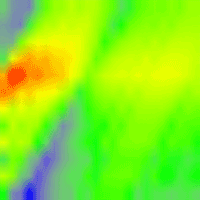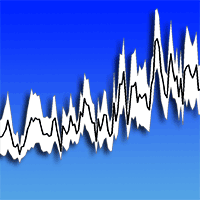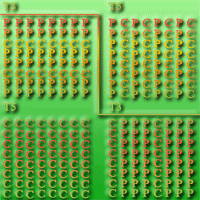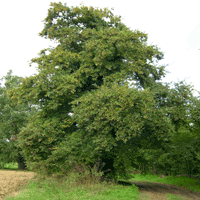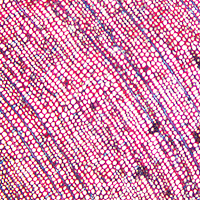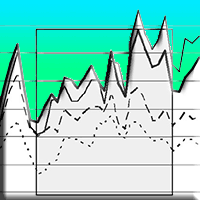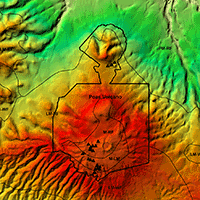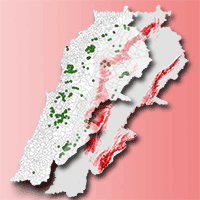Recent changes commonly observed in forests growth could be the result of a combination of different climatic and non-climatic factors, such as rising atmospheric [CO2], temperature changes, atmospheric N deposition and drought stress. These effects are difficult to assess, however, due to the superimposition of age-related changes. After removing age effects through a novel approach, this study quantifies the effects on tree growth of global change, and assesses the relationship with individual environmental drivers and their relative importance. Generalized Additive Mixed Models (GAMMs) were applied to decouple the non-linear effects of age and co-occurring environmental changes on basal area increments (BAI) series, as derived from tree rings in a Pseudotsuga menziesii stand chronosequence of four different age classes (65-, 80-, 100- and 120-year-old). The model could explain about 57% of the overall variation in BAI as a function of age and a selected set of predictors, including water availability in the current summer and at the end of previous growing season; together with age, winter-spring mean temperature was found to be the most important predictor. After accounting for age-related effects, a significant decrease in BAI was observed in Douglas fir over the last decades. No significant impact of atmospheric [CO2] and atmospheric N deposition were detected.
Keywords
, , , , ,
Citation
Ravaioli D, Ferretti F, Magnani F (2019). Disentangling the effects of age and global change on Douglas fir growth. iForest 12: 246-253. - doi: 10.3832/ifor2620-012
Academic Editor
Marco Borghetti
Paper history
Received: Sep 01, 2017
Accepted: Mar 11, 2019
First online: May 03, 2019
Publication Date: Jun 30, 2019
Publication Time: 1.77 months
© SISEF - The Italian Society of Silviculture and Forest Ecology 2019
Open Access
This article is distributed under the terms of the Creative Commons Attribution-Non Commercial 4.0 International (https://creativecommons.org/licenses/by-nc/4.0/), which permits unrestricted use, distribution, and reproduction in any medium, provided you give appropriate credit to the original author(s) and the source, provide a link to the Creative Commons license, and indicate if changes were made.

Breakdown by View Type
(Waiting for server response...)
Article Usage
Total Article Views: 43796
(from publication date up to now)
Breakdown by View Type
HTML Page Views: 37395
Abstract Page Views: 3021
PDF Downloads: 2509
Citation/Reference Downloads: 5
XML Downloads: 866
Web Metrics
Days since publication: 2441
Overall contacts: 43796
Avg. contacts per week: 125.59
Article Citations
Article citations are based on data periodically collected from the Clarivate Web of Science web site
(last update: Mar 2025)
Total number of cites (since 2019): 6
Average cites per year: 0.86
Publication Metrics
by Dimensions ©
Articles citing this article
List of the papers citing this article based on CrossRef Cited-by.
(1)
Aho K, Derryberry D, Peterson T (2014)Model selection for ecologists: the worldview of AIC and BIC. Ecology 95: 631-636.
CrossRef |
Gscholar
(2)
Ainsworth EA, Long SP (2005)What have we learned from 15 years of free-air CO
2 enrichment (FACE)? A meta-analytic review of the responses of photosynthesis, canopy properties and plant production to rising CO
2. New Phytologist 165: 351-71.
CrossRef |
Gscholar
(3)
Applequist MB (1958)A simple pith locator for use with off-centre increment cores. Journal of Forestry 56: 141.
Gscholar
(4)
Babst F, Alexander MR, Szejner P, Bouriaud O, Klesse S, Roden J, Ciais P, Poulter B, Frank D, Moore DJP, Trouet V (2014)A tree-ring perspective on the terrestrial carbon cycle. Oecologia 176: 307-322.
CrossRef |
Gscholar
(5)
Beedlow PA, Lee EH, Tingey DT, Waschmann RS, Burdick CA (2013)The importance of seasonal temperature and moisture patterns on growth of Douglas-fir in western Oregon, USA. Agricultural and Forest Meteorology 169: 174-185.
CrossRef |
Gscholar
(6)
Biondi F (1999)Comparing tree-ring chronologies and repeated timber inventories as forest monitoring tools. Ecological Applications 9: 216-227.
CrossRef |
Gscholar
(7)
Bouriaud O, Bréda N, Dupouey J-L, Granier A (2005)Is ring width a reliable proxy for stem-biomass increment? A case study in European beech. Canadian Journal of Forest Research 35: 2920-2933.
CrossRef |
Gscholar
(8)
Bunn AG (2008)A dendrochronology program library in R (dplR). Dendrochronologia 26: 115-124.
CrossRef |
Gscholar
(9)
Camarero JJ, Gazol A, Galván JD, Sangüesa-Barreda G, Gutiérrez E (2015)Disparate effects of global-change drivers on mountain conifer forests: warming-induced growth enhancement in young trees
vs. CO
2 fertilization in old trees from wet sites. Global Change Biology 21: 738-749.
CrossRef |
Gscholar
(10)
Carrer M, Urbinati C (2006)Long-term change in the sensitivity of tree-ring growth to climate forcing in
Larix decidua. New Phytologist 170: 861-872.
CrossRef |
Gscholar
(11)
Cherubini P, Dobbertin M, Innes J (1998)Potential sampling bias in long-term forest growth trends reconstructed from tree rings: a case of study from Italian Alps. Forest Ecology and Management 109: 103-118.
CrossRef |
Gscholar
(12)
Cook ER, Briffa KR, Meko DM, Graybill DA, Funkhouser G (1995)The “segment length curse” in long tree-ring chronology development for palaeoclimatic studies. The Holocene 5: 229-237.
CrossRef |
Gscholar
(13)
Daniels RF, Burkhart HE (1986)A comparison of competition measures for predicting growth of loblolly pine trees. Canadian Journal of Forest Research 16: 1230-1237.
CrossRef |
Gscholar
(14)
Emmingham WH, Waring RH (1977)An index of photosynthesis for comparing forest sites in western Oregon. Canadian Journal of Forest Research 7: 165-174.
CrossRef |
Gscholar
(15)
Esper J, Cook ER, Schweingruber FH (2002)Low-frequency signals in long tree-ring chronologies for reconstructing past temperature variability. Science 295: 2250-2253.
CrossRef |
Gscholar
(16)
Fernàndez-de-Una L, Mcdowell NG, Canellas I, Gea-Izquierdo G (2016)Disentangling the effect of competition, CO
2 and climate on intrinsic water-use efficiency and tree growth. Journal of Ecology 104: 678-690.
CrossRef |
Gscholar
(17)
Gandolfo C, Sulli M (1990)Vallombrosa 1872-1989: serie ultracentenaria di misure di precipitazioni e di temperatura in ambiente forestale. [Vallombrosa 1872-1989: precipitation and temperature ultracentenary series measurament in forest environment]. Annali dell’Istituto Sperimentale per la Selvicoltura 21: 147-181. [in Italian]
Gscholar
(18)
Gómez-Guerrero A, Silva LCRR, Barrera-Reyes M, Kishchuk B, Velázquez-Martínez A, Martínez-Trinidad T, Plascencia-Escalante FO, Horwath WR (2013)Growth decline and divergent tree ring isotopic composition (δ
13C and δ
18O) contradict predictions of CO
2 stimulation in high altitudinal forests. Global Change Biology 19: 1748-1758.
CrossRef |
Gscholar
(19)
Hastie TJ, Tibshirani RJ (1990)Generalized additive models. In: “Monographs on statistics and Applied Probability”. Chapman and Hall/CRC, New York, USA, pp. 4.
Gscholar
(20)
IPCC (2014)Climate change 2014 impacts, adaptation, and vulnerability. Part B: regional aspects (Barros VR, Field CB eds). Cambridge University Press, Cambridge, UK, pp. 1160.
Gscholar
(21)
Korner C (2005)Carbon flux and growth in mature deciduous forest trees exposed to elevated CO
2. Science 309: 1360-1362.
CrossRef |
Gscholar
(22)
Lee EH, Beedlow PA, Waschmann RS, Tingey DT, Wickham C, Cline S, Bollman M, Carlile C (2016)Douglas-fir displays a range of growth responses to temperature, water, and Swiss needle cast in western Oregon, USA. Agricultural and Forest Meteorology 221: 176-188.
CrossRef |
Gscholar
(23)
Lévesque M, Siegwolf R, Saurer M, Eilmann B, Rigling A (2014)Increased water-use efficiency does not lead to enhanced tree growth under xeric and mesic conditions. New Phytologist 203: 94-109.
CrossRef |
Gscholar
(24)
Linares JC, Camarero JJ, Carreira JA (2010)Competition modulates the adaptation capacity of forests to climatic stress: Insights from recent growth decline and death in relict stands of the Mediterranean fir
Abies pinsapo. Journal of Ecology 98: 592-603.
CrossRef |
Gscholar
(25)
Magnani F, Mencuccini M, Borghetti M, Berbigier P, Berninger F, Delzon S, Grelle A, Hari P, Jarvis PG, Kolari P, Kowalski AS, Lankreijer H, Law BE, Lindroth A, Loustau D, Manca G, Moncrieff JB, Rayment M, Tedeschi V, Valentini R, Grace J (2007)The human footprint in the carbon cycle of temperate and boreal forests. Nature 447: 848-850.
CrossRef |
Gscholar
(26)
Martínez-Vilalta J, Vanderklein D, Mencuccini M (2006)Tree height and age-related decline in growth in Scots pine (
Pinus sylvestris L.). Oecologia 150: 529-544.
CrossRef |
Gscholar
(27)
McCarroll D, Loader NJ (2004)Stable isotopes in tree rings. Quaternary Science Reviews 23: 771-801.
CrossRef |
Gscholar
(28)
McMahon SM, Parker GG, Miller DR (2010)Evidence for a recent increase in forest growth. Proceedings of the National Academy of Sciences USA 107: 3611-5.
CrossRef |
Gscholar
(29)
Medlyn BE, Badeck F-W, De Pury DGG, Barton CVM, Broadmeadow M, Ceulemans R, De Angelis P, Forstreuter M, Jach ME, Kellomäki S, Laitat E, Marek M, Philippot S, Rey A, Strassemeyer J, Laitinen K, Liozon R, Portier B, Roberntz P, Wang K, Jstbid PG (1999)Effects of elevated [CO
2] on photosynthesis in European forest species: a meta-analysis of model parameters. Plant, Cell and Environment 22: 1475-1495.
CrossRef |
Gscholar
(30)
Mencuccini M, Martínez-Vilalta J, Vanderklein D, Hamid HA, Korakaki E, Lee S, Michiels B (2005)Size-mediated ageing reduces vigour in trees. Ecology Letters 8: 1183-1190.
CrossRef |
Gscholar
(31)
Oren R, Ellsworth DS, Johnsen KH, Phillips N, Mccarthy H, Ewers BE, Maier C, Scha KVR, Hendrey G, Mcnulty SG, Katul GG (2001)Soil fertility limits carbon sequestration by forest ecosystems in a CO
2-enriched atmosphere. Nature 411 (6836): 469-472.
CrossRef |
Gscholar
(32)
Pavari A (1916)Studio preliminare sulla coltura delle specie forestali esotiche in Italia [Preliminar study on exotic species colture in Italy]. Annali del Regio Istituto Forestale Nazionale 7: 221. [in Italian]
Gscholar
(33)
Peters RL, Groenendijk P, Vlam M, Zuidema P (2015)Detecting long-term growth trends using tree rings: a critical evaluation of methods suplementary material. Global Change Biology 21 (5): 2040-2054.
CrossRef |
Gscholar
(34)
Piovesan G, Biondi F, Di Filippo A, Alessandrini A, Maugeri M (2008)Drought-driven growth reduction in old beech (
Fagus sylvatica L.) forests of the central Apennines, Italy. Global Change Biology 14: 1265-1281.
CrossRef |
Gscholar
(35)
R Core Team (2017)R: a language and environment for statistical computing. The R Foundation for Statistical Computing, Vienna, Austria.
Online |
Gscholar
(36)
Rehfeldt GE, Jaquish BC, Lòpez-Upton J, Sáenz-Romero C, St Clair JB, Leites LP, Joyce DG (2014)Comparative genetic responses to climate for the varieties of
Pinus ponderosa and
Pseudotsuga menziesii: realized climate niches. Forest Ecology and Management 324: 126-137.
CrossRef |
Gscholar
(37)
Rita A, Borghetti M, Todaro L, Saracino A (2016)Interpreting the climatic effects on xylem functional traits in two Mediterranean oak species: the role of extreme climatic events. Frontiers in Plant Science 7: 1-11.
CrossRef |
Gscholar
(38)
Soil Survey Staff (2014)Keys to soil taxonomy (12th edn). USDA-Natural Resources Conservation Service, Washington, USA, pp. 190-195.
Gscholar
(39)
Thornthwaite C (1948)An approach toward a rational classification of climate. Geographical Review 38: 55-94.
CrossRef |
Gscholar
(40)
Vicente-Serrano SM, Beguería S, López-Moreno JI (2010)A multiscalar drought index sensitive to global warming: the standardized precipitation evapotranspiration index. Journal of Climate 23: 1696-1718.
CrossRef |
Gscholar
(41)
Vicente-Serrano SM, Camarero JJ, Azorin-Molina C (2014)Diverse responses of forest growth to drought time-scales in the Northern Hemisphere. Global Ecology and Biogeography 23: 1019-1030.
CrossRef |
Gscholar
(42)
Vitas A, Zeimavičius K (2006)Trends of decline of Douglas fir in Lithuania: dendroclimatological approach. Baltic Forestry 12: 200-208.
Online |
Gscholar
(43)
Walker LR, Wardle DA, Bardgett RD, Clarkson BD (2010)The use of chronosequences in studies of ecological succession and soil development. Journal of Ecology 98: 725-736.
CrossRef |
Gscholar
(44)
Wigley TML, Briffa KR, Jones PD (1984)On the average value of correlated time series, with applications in dendroclimatology and hydrometeorology. Journal of Climate and Applied Meteorology 23 (2): 201-213.
CrossRef |
Gscholar
(45)
Wood SN (2006)Generalized additive models: an introduction with R. Chapman and Hall/CRC, New York, USA, pp. 119-150.
Gscholar
(46)
Yue C, Kohnle U, Hanewinkel M, Klädtke J (2011)Extracting environmentally driven growth trends from diameter increment series based on a multiplicative decomposition model. Canadian Journal of Forest Research 41: 1577-1589.
CrossRef |
Gscholar
(47)
Zang C, Biondi F (2015)Treeclim: an R package for the numerical calibration of proxy-climate relationships. Ecography 38: 431-436.
CrossRef |
Gscholar
(48)
Zhao M, Running SW (2011)Response to comments on “Drought-induced reduction in global terrestrial net primary production from 2000 through 2009”. Science 333: 1093-1093.
CrossRef |
Gscholar
